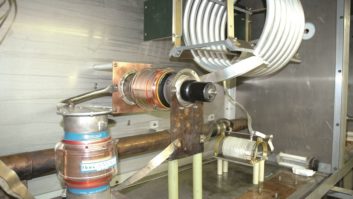You may not want to read this column while eating your breakfast.
(click thumbnail)Fig. 1: The new contract engineer should have smelled a rat as soon as he got here. In fact, he smelled and saw several.
(click thumbnail)Fig. 2: Rodent signs are visible.
(click thumbnail)Fig. 3: More mess in the rear of the rack.
(click thumbnail)Fig. 4: Those aren’t components on the back of that TFT unit.
(click thumbnail)Fig. 5: Even the transmitter didn’t escape unscathed.
A well-known friend to broadcasters, Walt Lowery tells us about a site that a friend took over on contract.
The new engineer made his first trip to the transmitter site, camera in hand. When he opened the door, he sent a number of large rats running for cover. They had taken residence in the equipment rack and Nautel transmitter, the rear door of which had been left open.
The room was full of spider webs. Clearly, no one had been in the building for months. The floor and every flat surface were covered with rat feces and urine. You can only imagine the smell.
Fig. 1 shows the front of the equipment rack; Fig. 2 is a close-up of the mess. It wasn’t any better in the back of the rack, as shown in Fig. 3.
Those aren’t resistors, my friend, scattered on the top of the TFT in Fig. 4! Even the Nautel transmitter was “home” to these invaders, as seen in Fig. 5.
Before doing any clean up, the contract engineer not only took photos but brought the local GM to the site. A haz-mat clean-up crew was dispatched to clean and sanitize the building. Another crew sealed all the cracks and holes in the building. The equipment rack and all the equipment in it were scrapped. The transmitter was cleaned as well as possible.
Lessons?
First, keep a camera with you, always; even a disposable flash model will do. Document any new contract site with pictures. You don’t want to be blamed for a predecessor’s mistakes.
Better yet, have the owner or GM accompany you to the site during your first visit. If there are repairs or upgrades required, you can explain them in person. Delegate nasty work like this to a company that specializes in such matters.
Disease is rampant in rodent and other animal leavings. Even breathing in this kind of closed environment can be hazardous.





. . .
Paul Kaminski of the Motor Racing Network, a fellow Radio World contributor, writes that he’s going to implement on his Web site the anti-spam java tip we discussed in the Aug. 29 issue.
He notes that he went to the site and found a couple of alternatives to the java, like making the address link “link” to a text file.
If the company and corporate IT guys want a reality check on how many e-mail lists the e-mail address is on, they can do a Google or other search by typing the address in quotation marks. It isn’t pretty. Paul’s been zipping off e-mails to each of the Web sites to ask them to delete the address.
Paul also offers a tip concerning e-mail security. Many station and outlet Web sites won’t accept attachments unless they are notified in advance that the attachment is coming. Many users aren’t sophisticated enough to realize that they can send attachments, the primary vector for virus infections, with their regular e-mail.
Here’s what Paul did: At his site’s media/PR contact page, he posted a link to the most complete site he’s found for changing e-mailers to send plain text. The link is www.expita.com/nomime.html
Paul writes that it’s only fair that he give people the means to change their mailer, after he tells them that he will delete unexpected attachments.
. . .
Don Setliff is a senior broadcast maintenance engineer with West Virginia Public Broadcasting. He adds his 2 cents’ worth of stupid operator stories.
At West Virginia Public Radio, live performance radio is still broadcast on certain days of the week. This usually involves miking choirs and chamber orchestras. One day, about 20 minutes into the performance, the radio engineer was called into the control room. The complaint was that the performers sounded “hollow and distant.”
After some investigation, it was found that the operator had punched up the wrong module, sending audio from off-mic. The right push of the right button corrected the problem. The operator claimed that he had checked everything thoroughly before show time.
Back when Don worked as master control operator for a TV station, the transmitter engineer called to say that the transmitter would be off for a few minutes for maintenance. There was no advance notice, he just pulled the plug and the station was off.
The program director called to say she couldn’t see the station on the TV in her office. Don informed the PD that the transmitter engineer had shut down for some troubleshooting.
She replied, “Well, put up a trouble slide!” Don’s answer was “No one would see the slide.” But this apparently wasn’t taken very well.
. . .
Looking for a way to organize cables in your shop or transmitter shack?
Reginald Swedber, chief engineer for KJNP(AM) at North Pole, Alaska, writes that garden hose hangers make great hangers for coax, Heliax and test cables.
They are cheap and easy to obtain, and they keep the cables from getting those kinks or flat spots that occur when hanging cables on a nail. It is also easy to keep cables neat when they can be hung up on a wall, rather than spread out on a shelf or floor. This allows you to select one for use and put it back easily.
Plastic garden hose hangers are used at the KJNP transmitter shack to store spare cables and cables made for test purposes. They also do well for hanging extension cords that are used for remotes.
. . .
(click thumbnail)Fig. 6: This instrument mic stand from On_Stage Stands works with many, but not all, on-air mics as well.
Ed Bukont of Commstruction, a national projects/project management company, says getting the mic off the table is not always an option.
He found a neat, inexpensive alternative to the typical Atlas DS-7 desk stand or those flimsy collapsible stands that blow over with every gust of wind. Ed’s find is a bass/kick-drum mic stand from On_Stage Stands, shown in Fig. 6.
It has a weighted base, short shaft and mini boom. It works well for getting the mic up where it needs to be, leaving the table free in front for hands and papers. The stand is versatile; you can remove the boom and use it as a regular desk stand. The only drawback is that the base is not heavy enough to support an RE-27 with shock mount. Other mics work fine.

. . .
Some time back we showed unique uses of the old Scientific Atlanta satellite receiver card cages. A similar query went out for cart machine uses once they’ve been replaced by a hard-drive system.
One engineer wrote that he wired up an old cart machine, relay and a phone coupler to page him every time the generator ran. With multiple sites, this gave him a heads-up on whether weekly tests were run. The cart machine played the touchtone “code” for that site, to be displayed on the pager.
The out-of-service machines also were used for doorstops and shelf book-ends.
Perhaps the most unique use comes from Radio World’s Alan Peterson. Demolishing a studio? Four cart machines welded together at the corners make a dandy wrecking ball.
Submissions for this column are encouraged, and qualify for SBE recertification credit. Fax your submission to (703) 323-8044, or send e-mail to [email protected].








